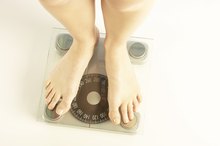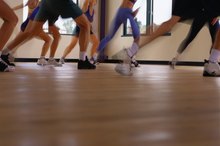What Is a Healthy Body Fat Percentage for Teenagers?
Body fat naturally fluctuates throughout your life, so it's normal for body fat levels to change when you're in your teens. Puberty also affects how your body stores fat, so it's normal for girls to gain fat because of hormonal changes. Although it's still important to eat healthy food and stay active in your teens, don't get too hung up on your teen bodily changes. If you're living a healthy lifestyle, it's likely you'll stay within a healthy body fat range, even if you look different from how you looked a few years ago.
Healthy Body Fat Percentage for Teens
As a kid, you probably had a body fat percentage of about 18 percent. Once hormones change during the teen years, girls gain more fat, while boys start to build more muscle. Teen girls might add 8 to 10 percent body fat, which they store in their breasts, pelvis, hips and thighs. Teen boys tend to lose body fat as they thin out. Teen girls should strive for a body fat percentage of between 21 and 23 percent; teen boys should aim for between 10 and 12 percent. As your body undergoes these changes, don’t fret too much about the numbers. For health reasons, though, girls should not exceed more than 30 percent body fat; boys should not exceed more than 20 percent.
- As a kid, you probably had a body fat percentage of about 18 percent.
- Teen girls might add 8 to 10 percent body fat, which they store in their breasts, pelvis, hips and thighs.
Risks of Too Little Fat
What Is Normal Body Fat?
Learn More
Fat tends to get a bad reputation, but your body depends on it. Without enough fat, your body loses its ability to keep you warm, protect your organs and absorb vitamins. Teen boys need at least 6 percent body fat, according to “A Matter of Fat: Understanding and Overcoming Obesity in Kids.” Teen girls should have at least 12 percent. If you are a teen girl and have less than 12 percent body fat, your hormones will be disrupted, and you’ll stop having your period. Also, you put your bones and muscles at risk, because they rely on those same hormones to stay healthy.
- Fat tends to get a bad reputation, but your body depends on it.
- If you are a teen girl and have less than 12 percent body fat, your hormones will be disrupted, and you’ll stop having your period.
Risks of too Much Fat
If you're concerned about your weight, speak with your doctor. A few extra pounds won’t harm you, but having too much body fat can cause health problems such as joint pain, diabetes, sleep problems and heart burn. It can also reduce your feelings of self-worth and cause you to feel depressed. The good news is that now is the best time to make changes. You can establish good eating habits and good exercise habits that will stay with you for the rest of your life. Set specific diet and exercise goals to accomplish each day. This will help you track your progress. Tune out negative self-talk and focus on your positive traits. Compliment yourself every day and rejoice in all the amazing things your body can do.
- If you're concerned about your weight, speak with your doctor.
- You can establish good eating habits and good exercise habits that will stay with you for the rest of your life.
Eating for a Healthy Weight
Hormonal Imbalance in Teenagers
Learn More
Eat a variety of nutrient-rich foods to maintain a healthy body fat percentage. Teen girls need at least 1,800 calories a day; teen boys need at least 2,200 calories. If you exercise or participate in sports, you’ll need even more calories. Keep your fat intake to between 25 and 35 percent of your total calories.
Eat plenty of the healthy fats found in fish, nuts and vegetable oils. Cut back on your intake of saturated fats found in potato chips, cookies and fatty cuts of meat like bacon and sausage. Gradually add more whole-grain foods to your diet such as whole-wheat breads, rice, pastas and cereals. The fiber will keep you feeling full longer so you’re less likely to grab an unhealthy, high-fat snack between meals. Make sure you eat at least one fruit or vegetable at every meal and select a variety of fruits and vegetables throughout the day.
Aim to get at least 60 minutes of exercise every day. You can do the exercise all at once or break it up into segments throughout the day. If you’re not into team sports, find a friend to walk, jog or swim with. There are a variety of yoga, dance or self-defense classes available that may suit you better. If you find something you enjoy and makes you feel good, you’re more likely to stick with that activity.
- Eat a variety of nutrient-rich foods to maintain a healthy body fat percentage.
- If you exercise or participate in sports, you’ll need even more calories.
Measuring Body Fat
At your annual physical exam, your doctor will probably use a height-to-weight chart or will calculate your body mass index to see if you’re at a healthy weight. These methods compare your weight and height to those of other kids your age and sex. These determine if you’re within a healthy weight range, but they don’t directly measure body fat.
Skin-fold measurements give a more accurate determination of body fat. This method uses a device called calipers to pinch the fat under your skin at various points on your body. Those measurements are then plugged into an equation to give you a percentage of your body fat.
Specialized facilities have more advanced techniques. Underwater weighing weighs you while you are submerged in a tank of water. This technique is based on the principle that lean people will sink but fatter people will float. These facilities may also use x-ray machines or other specialized machines to determine body fat.
- At your annual physical exam, your doctor will probably use a height-to-weight chart or will calculate your body mass index to see if you’re at a healthy weight.
- This method uses a device called calipers to pinch the fat under your skin at various points on your body.
Body Fat and Self-Esteem
As your body changes, your self-image might also change. Although it's tempting to compare your body to those other people have, avoid the temptation to do so. Not everybody grows and develops according to the same schedule or in the same way, but this doesn't mean one body type is better than another. If you're struggling with dieting and body image, consider speaking with a professional, or look into telephone support groups in your area. These groups allow you to discuss your concerns anonymously, without fear of others judging you.
- As your body changes, your self-image might also change.
- If you're struggling with dieting and body image, consider speaking with a professional, or look into telephone support groups in your area.
Related Articles
References
- University of Houston Center for Wellness Without Borders: Body Composition
- University of California Santa Barbara: UCSB Science Line: What Is an Acceptable Body Fat Range for Teenage Boys and Girls?
- Tanita: Body Fat Ranges for Children
- Rosemary Stanton: A Matter of Fat: Understanding and Overcoming Obesity in Kids
- Teens Health: Body Image and Self-Esteem
- Centers for Disease Control and Prevention: About Child and Teen BMI
- American Heart Association: Dietary Recommendations for Healthy Children
- Centers for Disease Control and Prevention. Physical activity: Children. Updated April 10, 2020.
- Harvard School of Public Health. The nutrition source, physical activity guidelines: How much exercise do you need? Updated November 20, 2013.
- KidsHealth by Nemours. Fitness and your 13-to 18-year old. Updated June 2019.
Writer Bio
Michelle Fisk began writing professionally in 2011. She has been published in the "Physician and Sports Medicine Journal." Her expertise lies in the fields of exercise physiology and nutrition. Fisk holds a Master of Science in kinesiology from Marywood University.









